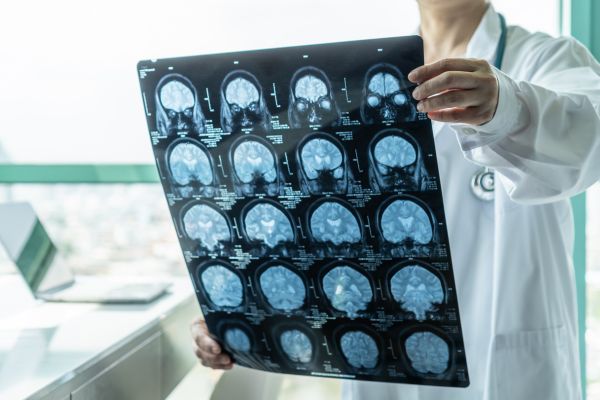
As a result, early diagnosis and detection are key for determining a treatment plan and lessening the chances of permanent disability.
During the diagnostic process, medical imaging assists with assessing the blood vessels and surrounding tissue. Learn how CT scans and magnetic resonance imaging (MRI) play a role.
What Is a Stroke?
The interruption of blood flow and oxygen to the brain causes varying degrees of damage and kills brain cells. People with high blood pressure and a history of smoking are more likely to experience a stroke, although age and genetics can also play a factor.
There are two main types of strokes:
- A hemorrhagic stroke involves a broken or ruptured blood vessel that causes blood to leak into the brain.
- An ischemic stroke occurs when a blood clot forms in the arteries. If the clot forms in a cerebral blood vessel, this is known as a thrombotic stroke. In other areas of the body, if the clot travels to the brain, this is called an embolic stroke.
Individuals may also experience a series of stroke-like symptoms lasting up to 24 hours, known as a transient ischemic attack or mini-stroke. While these usually do not result in permanent brain damage, they can indicate a more serious attack is coming in the future.
Symptoms vary based on the stroke’s location within the brain. Generally, someone may be having a stroke if you notice the following:
- Paralysis on one side of the body
- Difficulty speaking or understanding speech
- Sudden weakness
- Blurred vision in one or both eyes
- A sudden headache with no clear cause
- Numbness or weakness in the legs, arms or face
- Loss of balance and coordination
If you think you or a loved one is having a stroke, call 911 immediately.
While based on type and severity, stroke treatment involves improving blood flow to the brain for an ischemic stroke or controlling spilled blood that caused a hemorrhagic stroke.
Treatment may also include medications to break down clots or thin the blood, surgery, endovascular therapy and opening a blood vessel to deliver medicine to the affected area.
Diagnosing a Stroke with Imaging
A combination of bloodwork, an echocardiogram and medical imaging may be ordered to determine if a patient experienced an ischemic or hemorrhagic stroke and the degree of damage present.
CT Scan
Cross-sectional imaging of the head can determine if a blood clot or bleeding on the brain is present. This may be combined with CT angiography for a closer look at the brain’s blood vessels and CT perfusion for more information about blood flow.
Results can indicate the presence and size of certain abnormalities, such as tumors, blood clots and tissue receiving a lack of blood flow. To diagnose a stroke, a CT scan will indicate blood around the brain and skull, suggesting the presence of a hemorrhagic stroke, as well as conditions that mimic stroke symptoms.
MRI
MRI uses a magnetic field and radiofrequency waves to offer more insight into the body’s organs, soft tissue and internal structures, as well as other abnormalities that can mirror stroke symptoms. Along with examining blood flow, MRIs can indicate brain changes, particularly damage resulting from blocked blood flow.
Other Types of Imaging
Along with CT scans and MRIs, your doctor may recommend:
- Carotid Ultrasound: Using Doppler technology, a carotid ultrasound provides more information on arterial blood flow through the neck area. A transcranial Doppler ultrasound can better illustrate blood circulation within the brain.
- Angiography: Using CT or MRI technology and a contrast material, this imaging procedure offers additional insights, including blood clots and narrowed arteries. This can help pinpoint an aneurysm, blood vessel abnormalities and any blocked areas. Catheter angiography may also be performed for a similar assessment of the head and spine area.
To schedule a medical imaging procedure following a stroke, contact Midstate Radiology Associates today.












